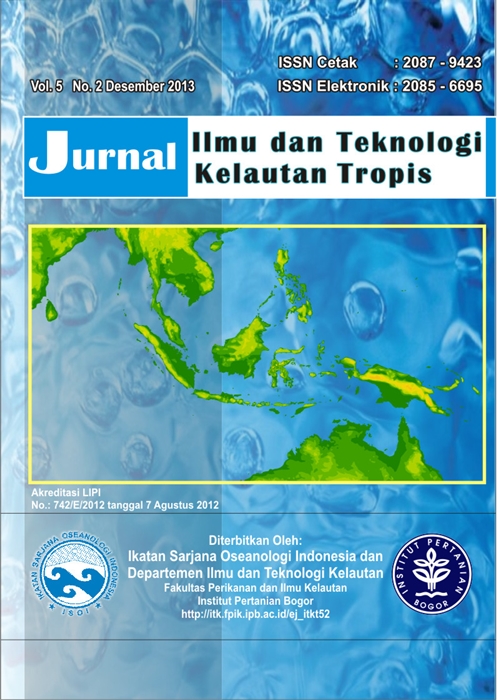Abstract
The purposes of this study were to determine the variability of temperature and its relation to regional processes in the Senunu Bay. The result showed clear vertical stratifications i.e., mixed layer thickness about 39-119 m with isotherm of 27°C, thermocline layer thickness about 83-204 m with isotherm of 14–26°C, and the deeper layer from the thermocline lower limit to the sea bottom with isotherm <13°C. Temperature and the thickness of each layers varied with season in which during the Northwest Monsoon the temperature was warmer and the mixed layer was thicker than those during Southeast Monsoon. During Southeast Monsoon, the thermocline layer rose about 24 m. The 2001, 2006, and 2009 (weak La Nina years), the Indonesia Throughflow (ITF) carried warmer water, deepening thermocline depth and reducing upwelling strength. In 2003 and 2008 thickening of mixed layer occurred in transition season was believed associated with the arrival of Kelvin Wave from the west. In 2002 and 2004 (weak El Nino period,) ITF carries colder water shallowing thermocline depth and enhancing upwelling strength. In 2007 was believed to be related with positive IODM where the sea surface temperature were decreasing due to intensification of southeast wind which induced strong upwelling. The temperature spectral density of mixed layer and thermocline was influenced by annual, semi-annual, intra-annual and inter-annual period fluctuations. The cross-correlation between wind and temperature showed significant value in the annual period.
Keywords: temperature, thermocline, variability, ENSO, IODM.
Authors
This work is licensed under a Creative Commons Attribution 4.0 International License.
Jurnal Ilmu dan Teknologi Kelautan Tropis i is an open-access journal, meaning that all content is freely available without charge to the user or their institution. Users are allowed to read, download, copy, distribute, print, search, or link to the full texts of the articles in this journal without needing to request prior permission from the publisher or the author.
All articles published by Jurnal Ilmu dan Teknologi Kelautan Tropis are licensed under the Creative Commons Attribution 4.0 International License. This allows for unrestricted use, distribution, and reproduction in any medium, provided proper credit is given to the original authors.
Authors submitting manuscripts should understand and agree that the copyright of published manuscripts is retained by the authors. Copyright encompasses the exclusive rights of authors to reproduce, distribute, and sell any part of the journal articles in all forms and media. Reproduction of any part of this journal, its storage in databases, and its transmission by any form or media is allowed without written permission from Jurnal Ilmu dan Teknologi Kelautan Tropis.


